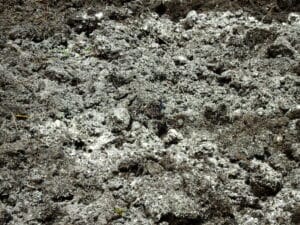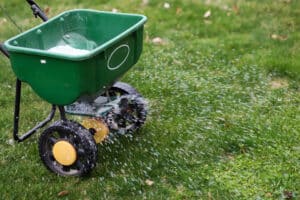Many homeowners have turfgrass covering their lawns, but a blanket of clover is worth considering instead. A clover lawn is low-maintenance and eco-friendly, requires little water, and prevents erosion. Learn why getting rid of clover could be a mistake in the guide below.
Find Lawn Help
- See our list of top lawn care companies based on in-depth research.
- Select the company that best meets your needs.
- Get a free, no-obligation quote for your home.
Get a Quote From Lawn Professionals Near You
Get a quote in as little as 5 minutes
Clicking “Get Your Estimate” submits your data to Home Service Quotes, which will process your data in accordance with the Home Service Quotes Privacy Policy.

Lime Soil Amendment

Lawn Fertilization
Why Should You Choose a Clover Lawn Over Grass?
Turfgrasses are popular for a reason, and they have some advantages over clover. Here are the benefits and drawbacks of clover as compared to turfgrasses such as Kentucky bluegrass, fine or tall fescue, and perennial ryegrass.
Pros
- Requires less frequent mowing and watering
- Is less expensive and more environmentally friendly
- Attracts pollinators and beneficial insects
Cons
- Isn’t as durable against foot traffic
- Doesn’t match everyone’s aesthetic taste
- May spread too aggressively
Traditional turfgrasses can create an even, lush appearance, but they require a lot of work, water, and fertilizer. You can spend hours weeding and mowing, and you may need to use toxic herbicides or pesticides for maintenance. Choosing clover instead of turfgrass can save you time and money while creating a more sustainable lawn.
Here is a more in-depth look at the benefits you can expect from a clover lawn:
Low Maintenance
Most turfgrasses require weekly mowing during their growing seasons, especially during summer, and occasional mowing at other times of the year. Clover only needs to be mowed a few times a year and is drought-tolerant. You won’t need to aerate or thatch clover, either.
Fewer Synthetic Chemicals
Turfgrasses deplete nitrogen from the soil as they grow and consequently require fertilizer. Clover traps nitrogen from the atmosphere, and when it dies, it returns this nitrogen to the soil. Clover also crowds out nuisance plants, which means you won’t need herbicides to kill weeds. It’s also pest-resistant.
Adaptable to Many Climates
Clover can grow in dry, nutrient-poor soils that would kill many types of turfgrass. Clover grows well in both sun and shade. It has a large taproot through which it can pull water and nutrients from deep beneath the soil surface.
Eco-Friendly
Fertilizers, herbicides, and pesticides that are typical of turfgrass lawns can pollute public waterways with runoff. Clover requires few to no synthetic chemicals and returns nutrients to the soil, making it more environmentally friendly than grass. Clover doesn’t guzzle water in dry climates, and its deep roots hold the soil together to prevent erosion. It attracts pollinators such as honeybees and butterflies.
Low Cost
White clover seed is less expensive than grass seed. A clover lawn also means you’ll save money in the long run on lawnmower gas, fertilizer, pesticides, herbicides, sprinkler systems, professional lawn care services, and other maintenance costs.
Kid- and Pet-Friendly
There’s no need to keep your kids and pets off your lawn during regular treatments of clover, as it doesn’t require the use of toxic chemicals. Dog urine won’t stain clover lawns, and clover is soft on bare feet.
How To Plant a Clover Lawn
If you’re sold on the concept of a clover lawn, follow the steps below to plant one.
- Choose Your Clover Type: White clover and microclover are the two most common types of clover seeds for lawn cover. We’ll compare and contrast clover types in the next section.
- Prepare Your Lawn: Clover and turfgrasses, such as Kentucky bluegrass and tall fescue, grow well together, minimizing the need for fertilizer and overseeding. Grass and clover seed mixes cost more than pure clover seed, though, and you’ll need to mow this hybrid lawn as frequently as you would mow turfgrass. If you want a pure clover lawn, you must remove your existing grass first. Rake the surface of the dirt to prepare for seeding. If you want a mixed lawn, mow your existing turfgrass to a height of about two inches, and dethatch the soil. This will allow the clover seed access to the soil.
- Spread the Clover Seeds: Most seed packaging will have instructions for distribution. Half a pound of seeds is typically sufficient to cover about 1,000 square feet of lawn. Attempt to spread the seeds evenly, as clumping will cause uneven growth.
- Water for the First Week: Keep the soil moist for about a week until the seeds have properly germinated. Water thoroughly in the early evening and lightly during the day unless there’s rain. Do not use fertilizer.
What Are the Different Types of Clover?
White clover and microclover are the most popular species for residential landscaping, but red clover is also popular. All three clover varieties are legumes that require little maintenance.
White Clover
White clover is scientifically known as Trifolium repens. It’s also commonly called Dutch clover, and it grows stems with three leaflets and small white flowers. White clover is a perennial plant, and its stalks can grow up to seven inches in a year. Dutch white clover is common ground cover because the seeds are inexpensive and grow aggressively.

Microclover
Microclover is a variant of Trifolium repens that’s bred for lawns. It grows less aggressively than white clover but more evenly. It blends well with traditional turfgrasses, as its leaves are smaller and its clovers grow fewer flowers. Microclover is sometimes more expensive than grass seed, though, and it doesn’t tolerate drought or shade as well as white clover.

Red Clover
Red clover is used less commonly for lawns because it can grow up to 18 inches tall if left unmowed. It also requires more frequent reseeding, and it doesn’t tolerate shade as well as white clover. Homeowners typically mix red clover with other types of clover or turfgrass.

How Can You Care for a Clover Lawn?
Caring for a clover lawn is relatively easy. Some homeowners mow clover only twice a year: once around midsummer to tidy it up and again a few weeks before the first frost of the season to get it ready for winter. Red and white clover require more frequent mowing than microclover.
Watering clover is only necessary for the first week of growth or if there’s a conspicuous dry spell. Fertilizing and aeration are unnecessary, as the clover maintains good soil conditions. White clover lawns will typically only require reseeding every few years and only in bare patches, but microclover and red clover will likely need more frequent overseeding.
- Never use broad-spectrum herbicide on a clover lawn. Clover is technically considered a weed, and most herbicides will kill it. Few weeds grow on a clover lawn thanks to its dense roots, so you shouldn’t need herbicide to kill weeds.
Our Conclusion
If you’re looking for a low-maintenance, eco-friendly grass alternative for your yard, consider planting a clover lawn. This inexpensive ground cover will stay green even in the shade or amid moderate drought conditions, and you may only have to mow clover twice a year. A clover lawn may not be right for everyone, but it is a more sustainable landscaping choice than turfgrass.
FAQ About Clover Lawns
Is a clover lawn dog-friendly?
Clover lawns are dog-friendly. They require no pesticides or herbicides, so they aren’t toxic to pets. Clover won’t discolor from dog urine like some turfgrasses do.
What are the downsides of a clover lawn?
One downside of planting a clover lawn is that clover doesn’t stand up to heavy foot traffic like traditional grass does. Clover can also attract stinging insects, and it tends to grow in aggressive clumps.
Does clover come back every year?
Clover grows back every year after the winter, but you may need to reseed every two or three years.
Is clover safe for kids?
Clover is safe for kids and requires no fertilizers, herbicides, or pesticides. It can sometimes attract stinging insects, though, and it’s more difficult to get clover stains out of clothes than regular grass stains.
How long do clover lawns last?
Clover lawns typically last two to three years before you need to reseed. Clover mixed with turfgrass will normally reseed itself for many years.






